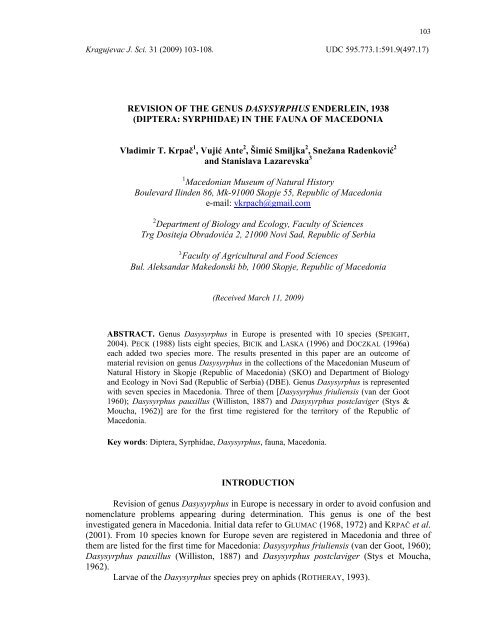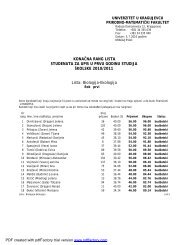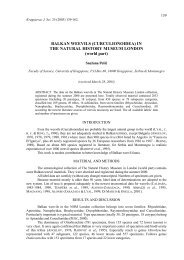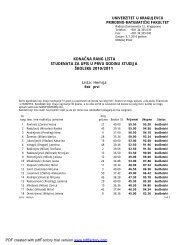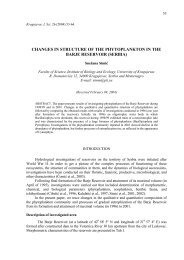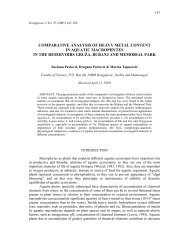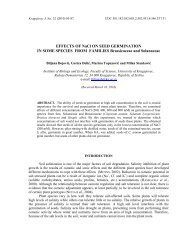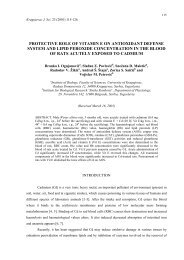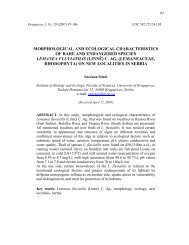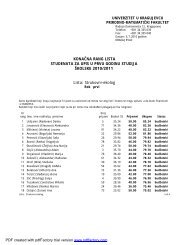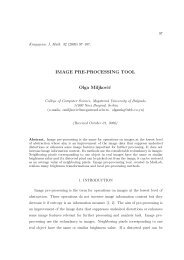Krpac 2009 Dasysyrphus.pdf - Flower Flies (Syrphidae)
Krpac 2009 Dasysyrphus.pdf - Flower Flies (Syrphidae)
Krpac 2009 Dasysyrphus.pdf - Flower Flies (Syrphidae)
You also want an ePaper? Increase the reach of your titles
YUMPU automatically turns print PDFs into web optimized ePapers that Google loves.
Kragujevac J. Sci. 31 (<strong>2009</strong>) 103-108. UDC 595.773.1:591.9(497.17)103REVISION OF THE GENUS DASYSYRPHUS ENDERLEIN, 1938(DIPTERA: SYRPHIDAE) IN THE FAUNA OF MACEDONIAVladimir T. Krpač 1 , Vujić Ante 2 , Šimić Smiljka 2 , Snežana Radenković 2and Stanislava Lazarevska 31 Macedonian Museum of Natural HistoryBoulevard Ilinden 86, Mk-91000 Skopje 55, Republic of Macedoniae-mail: vkrpach@gmail.com2 Department of Biology and Ecology, Faculty of SciencesTrg Dositeja Obradovića 2, 21000 Novi Sad, Republic of Serbia3 Faculty of Agricultural and Food SciencesBul. Aleksandar Makedonski bb, 1000 Skopje, Republic of Macedonia(Received March 11, <strong>2009</strong>)ABSTRACT. Genus <strong>Dasysyrphus</strong> in Europe is presented with 10 species (SPEIGHT,2004). PECK (1988) lists eight species, BICIK and LASKA (1996) and DOCZKAL (1996a)each added two species more. The results presented in this paper are an outcome ofmaterial revision on genus <strong>Dasysyrphus</strong> in the collections of the Macedonian Museum ofNatural History in Skopje (Republic of Macedonia) (SKO) and Department of Biologyand Ecology in Novi Sad (Republic of Serbia) (DBE). Genus <strong>Dasysyrphus</strong> is representedwith seven species in Macedonia. Three of them [<strong>Dasysyrphus</strong> friuliensis (van der Goot1960); <strong>Dasysyrphus</strong> pauxillus (Williston, 1887) and <strong>Dasysyrphus</strong> postclaviger (Stys &Moucha, 1962)] are for the first time registered for the territory of the Republic ofMacedonia.Key words: Diptera, <strong>Syrphidae</strong>, <strong>Dasysyrphus</strong>, fauna, Macedonia.INTRODUCTIONRevision of genus <strong>Dasysyrphus</strong> in Europe is necessary in order to avoid confusion andnomenclature problems appearing during determination. This genus is one of the bestinvestigated genera in Macedonia. Initial data refer to GLUMAC (1968, 1972) and KRPAČ et al.(2001). From 10 species known for Europe seven are registered in Macedonia and three ofthem are listed for the first time for Macedonia: <strong>Dasysyrphus</strong> friuliensis (van der Goot, 1960);<strong>Dasysyrphus</strong> pauxillus (Williston, 1887) and <strong>Dasysyrphus</strong> postclaviger (Stys et Moucha,1962).Larvae of the <strong>Dasysyrphus</strong> species prey on aphids (ROTHERAY, 1993).
106Reka, 1♀, 14.06.1991, (leg. Krpač); Oteševo, 1♀, 14.07.1991, (leg. Krpač); Pelister, JorgovKamen, 1700 a.s.l., 1♀, 29.07.1992, (leg. Krpač); Nidže, above Reder, meadow, on flowerVeronica chamaedrys and Ranunculus sp., 3♂♂, 3♀♀, 13.06.2002, (leg. Krpač); Nidže,Kajmakčalan, meadow, on flower of Ranunculus sp., 1950-2200 a.s.l., 1♂, 13.06.2002, (leg.Krpač). Nidže, above Reder, meadow, on flower of Veronica chamaedrys, 2♂♂, 1♀,14.06.2002, (leg. Krpač); Nidže, Kajmakčalan, meadow, on flower of Ranunculus sp., 2200a.s.l., 4♀♀, 14.06.2002, (leg. Krpač); Pelister, Lovačka Kuća, meadow, 3♂♂, 3♀♀,15.06.2002, (leg. Krpač); s. Mavrovo, meadow, on flower Euphorbia sp., 1♂, 17.05.2003,(leg. Krpač).Comment: D. pinastri was found in the mountains: Nidže, Bistra (in high mountainousmeadows) and Pelister (in dark conifer Pinus peuce forests), as well as in the canyon of theRadika river. Some authors D. pinastri have treated as D. lunulatus. GOELDLIN (1974) redefinedthis species and marked it as a lectotype. VOCKEROTH (1986, 1992) has disputed theidentity of lectotype of the species D. lunulatus, turning towards the manuscript of Thompsonand Nielsen who were claiming that D. lunulatus is synonim of D. venustus and suggested thename D. pinastri (De Geer) to be used for D. lunulatus. Unfortunately, there is not neotypemarked as D. pinastri. VOCKEROTH (1986) has defined his own concept of this species onlyon the basis of definitions given by COE (1953) and VAN DER GOOT (1981) - separate D.lunulatus from the D. lenensis (Bag.) and D. nigricornis (Verrall) (SPEIGHT, 2004).<strong>Dasysyrphus</strong> postclaviger (Stys et Moucha, 1962)New finding: Pelister, 2♂♂, 05.06.1990, (leg. Krpač); Pelister, Palisnopje, 1♂, 12.06.1991,(leg. Krpač); Pelister, Jorgov Kamen towards Crveni Steni, 1800 a.s.l., on raspberry, 3♀♀,11.07.1991, (leg. Krpač); Pelister, Kopanki, in coniferous forest, 1600 a.s.l., 1♀, 11.07.1991,(leg. Krpač); Mavrovo, Bunec, 1♂, 24.05.1995, (leg. Krpač); Nidže, Reder, meadow, onflower of Veronica chamaedrys, 1♂, 14.06.2002, (leg. Krpač); Nidže, Kajmakčalan, meadow,on flower of Ranunculus sp., 1♂, 14.06.2002, (leg. Krpač); Pelister, Lovečka Kuća, 1♂,15.06.2002, (leg. Krpač).Comment: D. postclaviger is mountaneous species, rare in Macedonia and has not beenregistered for Macedonia so far. According to available data its areal is not completely clear,due to inadequate separation from the similar species D. friuliensis (van der Goot) and D.hilaris (Zetterstedt) (SPEIGHT, 2004). On Balkan Peninsula it is noticed in Macedonia (whereit is not so rare species), in Montenegro and Serbia (unpublished, Šimić et al., 2001- checklist).<strong>Dasysyrphus</strong> tricinctus (Fallen, 1817)syn. Syrphus tricinctus (Fallen, 1817) in GLUMAC, 1968Published data: as S. tricinctus in GLUMAC, 1968: 871.Verified references: as S. tricinctus (GLUMAC, 1968): Mavrovo, river valley, on scrub, 1♀,27.08.1966, (leg. Glumac) SKO.New finding: Šar Planina, Popova Šapka, 1♀, 15-18.07.1958., (leg. S. Joksimović); Gotenplanina, 1♂, 2♀♀, 27.05.1988, (leg. Krpač); r. Radika, Lukovo Polje, 1♂, 06.09.1994, (leg.Krpač); v. Lazaropole, 3♂♂, 07.10.1994, (leg. Krpač); Nidže, above Reder, meadow, onflower of Ranunculus sp., 1♂, 13.06.2002, (leg. Krpač).Comment: This species is registered on the entire Balkan Peninsula and it settles downmainly in forests. In Macedonia it is not very rare species as GLUMAC (1968) told, but it isregistered only in individual examples on several localities on higher altitudes.<strong>Dasysyrphus</strong> venustus (Meigen, 1822)syn. Syrphus venustus Meigen, 1822 in GLUMAC, 1968sub. Syrphus arcuatus Fallen, 1817 in GLUMAC, 1968
107Published data: as S. venustus Meigen, 1822 in GLUMAC, 1968: 871; (KRPAČ et al.,2001:181-182).Erroneous literature data: as S. arcuatus in GLUMAC, 1968: 870: Mavrovo, mixed forest, onflower Euphorbia sp., 1♀, 30.05.1960., (leg. Glumac) SKO (= D. venustus).Verified references: as S. venustus Meigen, 1822 in GLUMAC, 1968: Kožuf planina, GolemaPoljana, 1♂, 18.06.1956., (leg. Bogoevski) DBE.(KRPAČ et al., 2001): Mavrovo, Bunec, ass. Festuco heterophyllae Fagetum, 1♀, 25.05.1995,(leg. Krpač); Bistra planina, Carevec, ass. Fagetum subalpinum scardo-pindicum, 1♀,17.06.1994, (leg. Mihajlova) SKO.New finding: Goten Mt, 1♀, 27.05.1988, (leg. Krpač); Bistra Mt, Carevec, 1♀, 17.06.1994,(leg. Mihajlova); Mavrovo, v. Nikiforovo 2♂♂, 23.05.1995, (leg. Krpač); Mavrovo, 2♂♂,1♀, 24.05.1995, (leg. Krpač); Galičnik 1♂, 24.05.1995, (leg. Krpač); Mavrovo, Bunec 1♀,25.05.1995, (leg. Krpač); Jablanica, 2♀♀, 07.06.1995, (leg. Krpač); Galičica, 1♂, 3♀♀,08.05.1995, (leg. Krpač); Nidže, Kajmakčalan, 2200 a.s.l., on flower of Ranunculus sp., 1♀,14.06.2002, (leg. Krpač).Comment: This species ocupies a very wide area. It is the most frequent in forestsecosystems. In Macedonia it was noticed at only two localities and in a few number ofspecimen, but our investigations showed that it is not as rare as GLUMAC (1968) assumed.Revision of material from the collection of Museum SKO we found out that specimenbelonging to S. arcuatus, and published with GLUMAC (1968), refer to D. venustus. Todayconcept of this species is confused and temporary. Since revision is in process, it is expectedclarification of status of this taxon and extending adequate basis for difference from similarspecies (SPEIGHT, 2004).CONCLUSIONUpon revision of literature data and re-determination of the specimens of genus<strong>Dasysyrphus</strong> (Diptera: <strong>Syrphidae</strong>) from the area of Macedonia seven taxa are stated. Three ofthem [<strong>Dasysyrphus</strong> friuliensis (van der Goot, 1960); <strong>Dasysyrphus</strong> pauxillus (Williston, 1887)and <strong>Dasysyrphus</strong> postclaviger (Stys et Moucha, 1962)] are registered in the fauna ofhoverflies of Macedonia for the first time. It is amounting 42,85% newly stated species.Upon revision and re-determination of Museum material SKO and as a result of the recenttaxonomic investigations worldwide, we have discovered that one taxon of species listed byGLUMAC (1968), was erronously identified. Specimen referred to S. arcuatus are revised andrefered to D. venustus. S. arcuatus is excluded from the list of hoverflies of Macedonia.References:[1] BICIK, V., LASKA, P., (1996): Revision of type material of Scaeva obscura Zetterstedt,1838 (Diptera, <strong>Syrphidae</strong>). Acta Univ. Palacki, Olomouc, Fac. rer. nat., Biol., 33 (1993-95): 7-14.[2] COE, R. (1953) Diptera: <strong>Syrphidae</strong>. Handbks. ident. Br. insects, R. ent. Soc. London 10(1): 1-98.[3] DOCZKAL, D., (1996a): Schweibfliegen aus Deutschland: Erstnachweise und wenigbekannte Arten (Diptera, <strong>Syrphidae</strong>). Volucella, 2: 36-62.
108[4] GLUMAC, S., (1968): Sirfide (Syrphoidae, Diptera) u Makedoniji. Godišnjak Filozofskogfakulteta u Novom Sadu. Knjiga 11, Novi Sad, 1968: 845-880.[5] GLUMAC, S., (1972): Catalogus Faune Jugoslavije, Syrphoidea. III/6. SlovenskaAkademija znanosti i umjetnosti: 1-71. Ljubljana.[6] GOELDLIN DE TIEFENAU, P., (1974): Contribution a l'etude sistematique et ecologiquedes <strong>Syrphidae</strong> (Dipt.) de la Suisse occidentale. Bull. Soc. Ent. Suisse, 47: 151-252.[7] KRPAČ, V., ŠIMIĆ, S., VUJIĆ, A., (2001a): New data on hoverflies (Diptera, <strong>Syrphidae</strong>) inthe National Park Mavrovo. 75 years Macedonian Museum of Natural History, Skopje:179-185.[8] PECK, L. V., (1988): <strong>Syrphidae</strong>. In SOOS, A. and PAPP, L., (eds.): Catalogue ofPalaearctic Diptera, Akad. Kaido. Budapest 8: 11-230.[9] ROTHERAY, G. E. (1993): Color guide to hoverfly larve. Dipterist Digest 9:1-156.[10] SACK, P. (1928-32): Die Fliegen der Palaerktischen Region, 31. <strong>Syrphidae</strong>. Stuttgart(Schweizerbart), 1-451.[11] SCHUMANN, H., BAHRMANN, R., STARK, A. (1999): Checkliste der DipterenDeutschlands. Studia Dipterologica, Supplement 2: 195-203.[12] SPEIGHT, M. C. D. (2004): Species accounts of European <strong>Syrphidae</strong> (Diptera) 2004. In:SPEIGHT, M.C.D., CASTELLA, E., SARTHOU, J.-P. and MONTEIL, C. (eds.): Syrph the Net,the database of European <strong>Syrphidae</strong>, vol. 44, 235 pp., Syrph the Net publications,Dublin.[13] STUBBS, A. E., FALK, S. J., (1983): British hoverflies: an illustrated identification guide.Br. Ent. Nat. Hist. Soc., London, 253pp.[14] VAN DER GOOT, V. S., (1981): De zweefvliegen van Niirdwest - Europa en EuropeesRusland, in het bijzonder van de Benelux. KNNV, Uitgave, Amsterdam, No. 32: 275.[15] VAN VEEN, M. (2004): Hoverflies of Northwest Europe: identification keys to the<strong>Syrphidae</strong>. KNNV Publishing, Utrecht: 256pp.[16] VOCKEROTH, J. R. (1986): Nomenclatural notes on Nearctic Eupeodes (includingMetasyrphus) and <strong>Dasysyrphus</strong> (Diptera: <strong>Syrphidae</strong>). Can. Ent., 118: 199-204.[17] VOCKEROTH, J. R., (1992): The flower flies of the Subfamily Syrphinae of Canada,Alaska and Grenland (Diptera, <strong>Syrphidae</strong>). The insects and arachnids of Canada.Agriculture, Canada, Pt. 18, 1-456.


